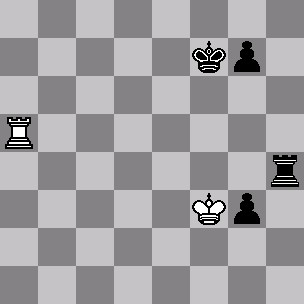22.12.2005
Round 4: Svidler-Rublevsky, Dreev-Jakovenko
*Feel free to send your questions to Konstantin: sakaev@e3e5.com. Please also include your name and location.*
Live commentary by Konstantin Sakaev
Svidler, P (2740) - Rublevsky, S (2652)
ch-RUS superfinal Moscow, Russia (4), 22.12.2005
1.e4 c5 2.Nf3 e6 3.d4 cxd4 4.Nxd4 Nc6 5.Nc3 a6 6.Be2 d6 7.Be3 Bd7 8.a4 Nf6 9.0-0 Be7 10.f4 Nxd4 11.Qxd4 Bc6
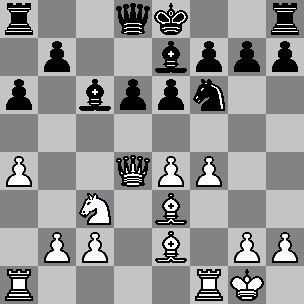
12.b4! 0-0 13.b5 Be8 14.e5 Qc7
Svidler has the initiative. The idea to play b2-b4-b5 was effectively used by Anand, who won a good game in his match with Kasparov. The pawn on b5 restricts Black's light-squared bishop. Svidler carried out this idea gaining a tempo in passing, so it looks like his position is clearly better.
By the way, afternoon traffic jams in downtown St.Petersburg are terrible.
15.b6 Qc6 16.exd6 Qxd6 17.Bf3 Qb8
It turns out that only 17...Qb8 is a novelty prepared by Rublevsky. Earlier Black used to play 17...Qxd4 18.Bxd4 Rd8. The resulting endgame is unpleasant for Black. Two years ago Rublevsky barely made a draw against Jakovenko. Dmitry played 19.Rfd1, but it seems after 19.Bf2 Black's position is just bad. No wonder Sergey deviates. Judging by the clocks, he prepared 17...Qb8 at home. Still, I did not get the impression that this move solves all the problems.
Dreev-Jakovenko. Dreev used an interesting opening idea. Earlier 10...Nb4 had been met by 11.Qd2. After 11...Ne4 12.Nxe4 dxe4 13.a3 exf3 14.Bxf3 Nc6 15.d5 Ne5 16.dxe6 Nxf3+ 17.gxf3 fxe6 18.Qc2 the game Aleksandrov-Bacrot, 2004 continued 18...Qg5+ 19.Kf1, and White failed to use advantages of his position, but later it turned out that his play can be improved. However, in my Khanty Mansiysk game with Erenburg the Israeli grandmaster proved that after 18...Bd6! Black equalizes. The text-move was considered inferior, but Dreev's idea 12.е4 looks quite promising.
18.Qe5. Of course, it is useful for White to transpose to the endgame because of the weakness on b7, but it looks like Black solves his problems by playing 18...Qc8 19.Bd4 Bc6. For White 18.Rae1 deserved attention: 18...Qc8 19.f5 Bc6 20.fxe6 fxe6. White has a small advantage because of the weakness on e6. Dangerous is 19...exf5 in view of 20.Bf2, and Black has problems with his e7-bishop.
Kramnik-Zvjaginsev. Zvjaginsev turned unprepared to an old scheme 9.Bd2 instead of much-played 9.b4. The text-move had been popular 30 years ago. Vadim doesn't see to know the theory there - he takes a lot of time and his play is not confident.
18...Bd6
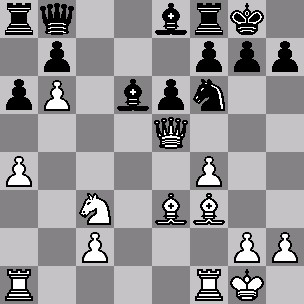
19.Qd4 Be7 20.Qe5. Game drawn. ½-½
A surprising decision to avoid the struggle. After 18...Bd6 White could play 19.Qa5 instead of repreating the moves. This is how he should have played in order to fight for an advantage! Rublevsky rejected 18...Qc8 - maybe he was worried about 19.f5!? After 19...Nd7 20.Qa5 Bf6 21.Ra3 White has an initiative position.
Dreev,A (2694) - Jakovenko,D (2644)
Superfinal Moscow, Russia (4), 22.12.2005
1.d4 d5 2.c4 c6 3.Nc3 Nf6 4.e3 a6 5.Qc2 e6 6.Nf3 c5 7.cxd5 exd5 8.Be2 Nc6 9.0-0 Be6 10.Rd1 Nb4 11.Qb1 Qc8 12.e4 Nxe4
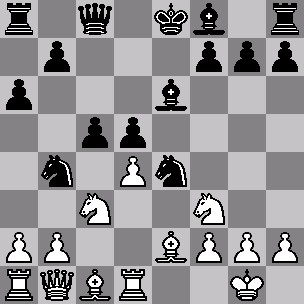
13.Re1 A novelty. In the only game that I found in the database White proceeded 13.Nxe4 Bf5 14.Nfg5, and after 14...h6? 15.Re1 hxg5 16.Bg4 he created a decisive attack, Arkell,K-Haslinger,S/Birmingham 2005. Correct was 14...dxe4 15.Nxe4 cxd4 (15...Qe6!? is also interesting) 16.Bd3 Nxd3 17.Qxd3 Be7 18.Qxd4 0-0 with equality.
13...Be7. Extremely risky is 13...f5 14.Na4 Qc6 15.Nxc5 Bxc5 (15...Nxc5 16.dxc5 Bxc5 17.Bd1! Qb6 18.Re2, and there is no defense against the threat a2-a3) 16.dxc5 Qxc5 17.Be3 Qc2 18.Nd4 Qxb1 19.Raxb1 Kd7 20.f3 Nd6 21.Bd2 a5 (21...Nc6 22.Nxe6 Kxe6 23.Bc4+ Kd7 24.Bxd5±) 22.a3 Nc6 23.Nxe6 Kxe6 24.Bc4+ Kd7 25.Bxd5±
14.Nxe4 dxe4 15.Qxe4 0-0 16.a3 Qc6 17.Qb1 Nd5 18.Bd3 h6 19.Ne5
Other moves do not offer anything more than equality: 19.dxc5 19...Qxc5 20.b4 Qb6 21.Bb2 Bf6= ; 19.Bh7+ Kh8 20.Bf5 Bxf5 21.Qxf5 cxd4 (21...c4 22.Ne5 Qf6 23.Qe4±) 22.Nxd4 Qd6 23.Qh5 Nf6 24.Qh4 Qd7 25.Nf3 Rae8.
19...Qc8. 19...Qb6 looked more active.
20.Bd2!? A fighting move: 20.dxc5 Qxc5 led to a simple equality.
20...cxd4 21.Qd1! The only way to continue the struggle, otherwise the position quickly simplifies. The pawn sacrifice is temporary, as the d4-pawn will eventually fall, and now White tries to use an awkward position of Black's queen.
21...Re8 22.Qf3 Qd8 23.Qe4. As a result of Dreev's imaginative play, White got a small advantage, here is a sample variation: 23...Nf6 24.Qxb7 Rb8 25.Qxa6 Rxb2 26.Nc6.
Meanwhile, Bareev has a technically winning position after 27 moves. Kramnik has a big advantage against Zvjaginsev.
23...f5 Now White is slightly better, because the bishop on e6 is somewhat lacking protection. Nevertheless, Black is close to equality. 23...Nf6 24.Qxb7 Rb8 25.Qxa6 Rxb2 26.Nc6.
24.Qxd4 Bf6 25.Rad1 Qb6. It was also possible to complete the development by brining the last piece into play: 25...Rc8.
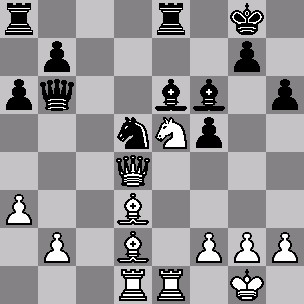
Morozevich-Khalifman. In my opinion, instead of 23...Rxh4?! Black could give up an exchange under better circumstances: 23...Rh5 24.Nf5+ Qxf5. In any case, this is a more stubbon continuation. And now White's position after the 27th move is close to winning.
26.Qxb6 Nxb6 27.Ba5?! (27.f4 is simpler) 27...Na4. 27...Bb3 also equalizes, but the text-move is sharper.
28.Nc4 Nxb2 29.Nxb2 Bxb2
In the game Kramnik-Zvjaginsev Vladimir retains a serious advantage. He will now make five nothing moves to reach the control move, and then he can start working on it... Nope, the players just agreed to a draw. Well, White has no direct play, but his position is better, so he could still play on, thus Kramnik's decision is rather surprising.
30.Rb1. Correct is 30.a4!, and Black can't win as he has two weaknesses (on b7 and f5).
30...Bxa3 31.Rxb7 Bd5! Exchanges suit Black - the activity of White's pieces decreases, and White's back rank weakens.
32.Rxe8+ Rxe8 33.Rd7 Be6 34.Ra7 Rc8 35.Kf1 Bc4 36.Ke2 The pawn may not be regained: 36.Bxc4+ Rxc4 37.Rxa6 Ra4.

36...Re8+?! Stronger is 36...Bb5!, threatening to invade the second rank with the rook. 37.Bxb5 axb5 38.Rb7 Rc2+ 39.Ke1 Rc5! (but not 39...Bc5 40.Rxb5 Bxf2+ 41.Kd1 Rc5 42.Rxc5 Bxc5 43.Ke2 and White draws). Then the rook should be placed on d5, the bishop stands on f6, and the king goes to g6 via h7. Black has winning chances.
37.Kd2 Bxd3 38.Kxd3 Re6. Black had almost no hope to win in the endgame 3 vs. 2 that arises after 38...Bc5 39.Rxa6 Bxf2, as trading the rooks suits White, and if his king crosses the e-file, it becomes possible to trade bishops, transposing to a rook ending.
39.Bc3. In such positions it is important to control the long diagonal. Now White is closer to a draw than Black is to a win.
39...Rg6 40.Ra8+ Kh7 41.g3 Bc5 42.Ke2 Re6+ 43.Kf3 Be7. A more energetic 43...g5!? deserved attention.
44.h4. Removing the aforementioned possibility.
44...h5 45.Ra7 Kg6 46.Bd4 Bf6 47.Be3. In my opinion, the rook ending arising after 47.Bxf6 Kxf6 is closer to a draw; in any case, the presence of dark-squared bishops hardly makes White's task easier.
47...Rc6 48.Kg2 Be5 49.Bg5 The position is very close to a draw, but the game may go on until the end of the third control...
49...Bd4 50.Rd7 Bf6 51.Bd2 Be5 52.Bg5 Bc3 53.Ra7 Kh7 54.Kf3 Kg6 55.Kg2 a5 56.Bd8 Rc5 57.Kf3 Rd5 58.Bg5 Rb5 59.Bd8 Rb3 60.Kf4 Bd2+ 61.Ke5 Rb5+ 62.Kd4 Be1 63.Ke3 Rb2 64.Ra6+ Kh7 65.f3 Rb3+ 66.Ke2 Bc3 67.Bc7 Ra3 68.Bd6 Ra2+ 69.Ke3 Ra4 70.Bc7 Kg8 71.Kd3 Ra3 72.Kc4 Bb4 73.Be5 Re3 74.Kd5 Bc3 75.Bxc3 Rxc3 76.Rxa5 Kf7 77.g4 fxg4 78.fxg4 hxg4 79.Ke4 Rh3 80.Kf4 g3 81.Kf3 Rxh4
Game drawn. ½-½
Back to the Superfinal main page

